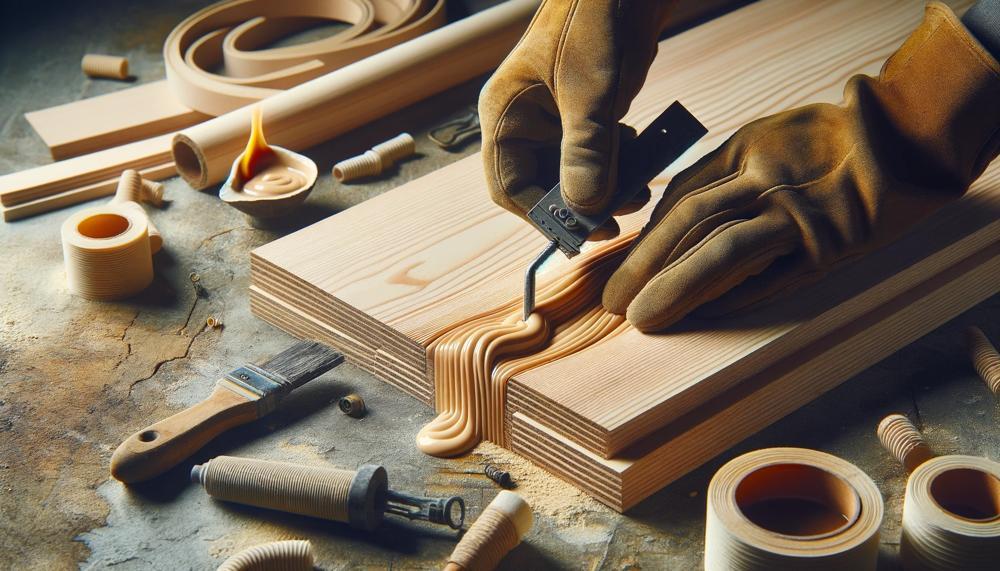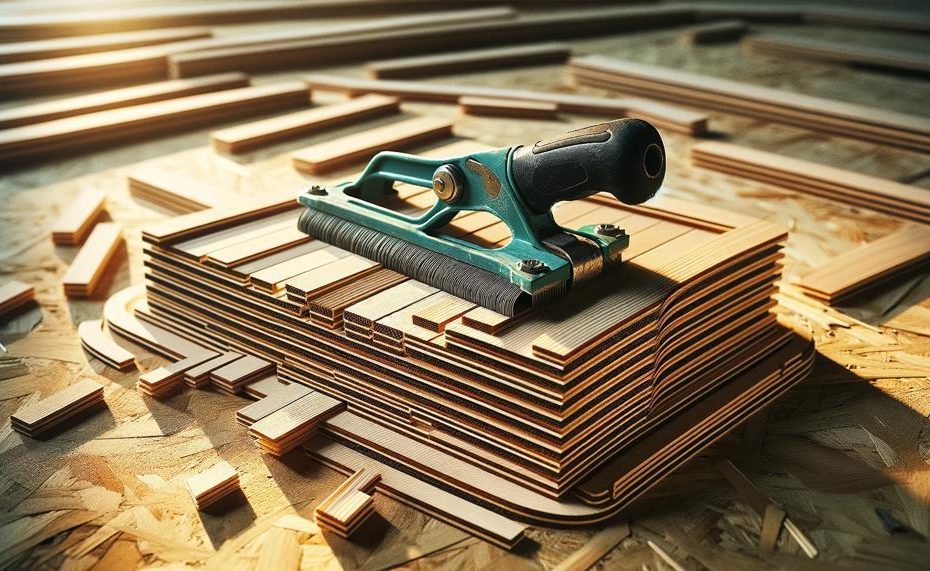Starting a woodworking project is exciting because it requires creativity and inventiveness. The way you use to connect materials may make all the difference, particularly when it comes to plywood to plywood.
This blog article provides a new viewpoint on this time-tested method by delving into the specifics of using glue to join plywood layers.
We will walk you through the steps, explain the what, why, and how of the process, and make sure you have everything you need to get a flawless, long-lasting finish.
So, can i glue plywood to plywood?
Yes, you can glue two pieces of plywood together using wood glue. However, a butt joint glued with only wood glue is weak and will fail when the table is bumped. To make the joint stronger, you can add a back to the table that’s glued to both the top and the supports. You can also use clamps around the edges, and a few nails to keep everything in place is a good idea.
Let’s dive in.
Table of Contents
- 1 What is the best glue for plywood to plywood?
- 2 Advantages of Using the Right Glue for Plywood Bonding
- 3 Types of Glues Used for Plywood Bonding
- 4 Polyurethane Glue: The Best Glue for Plywood Bonding
- 5 Epoxy Glue: An Alternative to Polyurethane Glue
- 6 Carpenter’s Glue and Aliphatic Resin Glue: Traditional Options
- 7 Factors to Consider When Choosing a Glue for Plywood Bonding
- 8 Specialized Adhesives for Extreme Conditions
- 9 Conclusion
What is the best glue for plywood to plywood?
The best glue for bonding plywood to plywood is polyurethane adhesive. This choice hinges on several factors crucial for a successful bond. Let’s break down these elements and consider other glues that can also be effective:
Key Considerations:
- Bonding Strength: Glue must form a strong bond to withstand stresses.
- Moisture Resistance: Essential for environments with varying humidity.
- Temperature Fluctuations: The glue should maintain integrity in diverse temperatures.
- Versatility: Effective across different plywood types.
- Application Ease: User-friendly application process.
Glue Comparison:
| Type of Glue | Strengths | Limits |
| Polyurethane Adhesive | High bonding strength, resistant to moisture and temperature, versatile, easy to apply | Slightly higher cost |
| Epoxy Glue | Strong bond, good for damp environments | More complex mixing and application process |
| Marine-grade Adhesives | Exceptional moisture resistance | Primarily for outdoor or marine use |
| Cyanoacrylate Glue | Quick setting | Less effective for large surfaces |
| UF, PF, MUF Glues | Specifically designed for wood, strong bond | May require precise conditions for optimal bonding |
| PVA/Wood Glue | Easy to use, economical | Not ideal for moist or hot conditions |
Advantages of Using the Right Glue for Plywood Bonding
Choosing the right type of glue for bonding plywood is not just about sticking pieces together; it’s an art that combines science with practical wisdom, ensuring your woodworking projects stand the test of time.
Phenomenal Bonding Strength
| Feature | Benefit | Example Glues |
| Deep Penetration | Ensures a durable bond, resistant to wear and tear. | Polyurethane, PVA |
| Moisture Resistance | Ideal for projects exposed to elements or high humidity. | Epoxy, Marine-grade adhesives |
| Versatility | Compatible with various materials beyond just plywood. | Cyanoacrylate, UF/PF/MUF glues |
Simplicity and Efficiency
Glues tailored for plywood make the application process a breeze. They’re formulated to spread evenly, allowing for a tidy workspace and minimal waste.
Quick setting times and the ability to make adjustments before the glue dries offer both speed and flexibility in project timelines.
Cost-Effectiveness
Not only are these adhesives affordable, but their efficiency in use means you get more bang for your buck.
A small amount goes a long way in creating strong bonds, reducing the need for frequent repurchases.
Durability and Longevity
By resisting temperature fluctuations and moisture, the right glue ensures your creations can withstand environmental challenges, prolonging the life of your projects.
This resilience is key in outdoor or high-wear items.
Preparation and Application Tips
Proper surface prep is a must; a clean, slightly roughened surface enhances glue adhesion.
Applying the correct amount and using clamps as needed ensures an even, secure bond without weak spots.
Types of Glues Used for Plywood Bonding
When you’re looking to bond plywood together, the glue you choose can make all the difference.
It’s like picking the right tool for the job—each type of glue has its own special qualities that can help you achieve a rock-solid bond, tailored to your project’s needs. Here’s the lowdown on the adhesives that’ll do the trick:
| Glue Type | Main Features | Best For |
| Phenol Formaldehyde (PF) | Strong grip, water-resistant, heat-proof | Outdoor or marine projects, high-temp spots |
| Melamine Urea Formaldehyde (MUF) | Decent water resistance, longer work time, less formaldehyde emission | General plywood bonding, safer indoor use |
| Polyvinyl Acetate (PVA) | User-friendly, longer work time, dries clear | Interior and decorative uses |
| Epoxy | Super strong, water and heat-resistant, versatile | Almost anything, indoors or out |
| Polyurethane (PU) | Strong bond, water-resistant, expands when curing | Interior/exterior use, tricky surfaces |

Recall that this is more complicated than just applying adhesive and calling it a day. A decent relationship may become a terrific one with proper preparation. Just quickly wipe the plywood to remove any dust or particles. Put a generous amount of glue on there and smooth it out evenly.
Then, join those fragments as if they were old friends. When handling large sheets, don’t forget to include a few of screws as a precaution.
Polyurethane Glue: The Best Glue for Plywood Bonding
Superior Bonding Strength
- Creates a robust bond that withstands stress and heavy use.
Moisture and Temperature Resistance
- Excels in outdoor settings or areas prone to humidity.
Versatile with Different Plywood Types
Ease of Application
- A simple process that requires just a thin layer for effective bonding.
Comparison Table:
| Glue Type | Bonding Strength | Moisture Resistance |
| Polyurethane Glue | High | Excellent |
| Epoxy | Moderate to High | Good |
| PVA (Polyvinyl Acetate) | Moderate | Poor to Moderate |
This table shows why polyurethane glue is the go-to adhesive for plywood projects, especially when strength and durability are top priorities.
Other glues may have their merits but fall short in one aspect or another compared to the all-around capabilities of polyurethane adhesive.
Epoxy Glue: An Alternative to Polyurethane Glue
Epoxy glue shines as a sterling choice for affixing plywood to plywood, outmatching polyurethane glue in several key aspects.
Superior Strength and Durability
Epoxy’s robust composition ensures an indomitable bond, capable of shouldering hefty loads and relentless stress, which safeguards the project’s structural soundness.
Moisture Resistance
With its formidable defense against water and moisture, epoxy is apt for exterior applications or environments prone to dampness.
Compatibility with Finishes
Designed with plywood in mind, epoxy glue melds seamlessly with various finishes, maintaining the aesthetic integrity of the workpiece.
Faster Curing Time
Its rapid curing rate, coupled with an extended open time, facilitates a smooth application process, minimizing the likelihood of mishaps.
Gap-Filling Properties
Epoxy’s adeptness at bridging gaps ensures a cohesive and sturdy union, even on irregular surfaces.
Long Open Time
The blend of epoxy resin and hardener offers ample time for meticulous alignment, paving the way for precision before setting commences.
Temperature Resilience
Unfazed by thermal extremes, epoxy glue retains its adhesive qualities in both sweltering heat and bitter cold.
Versatile Plywood Bonding
Its efficacy extends across various plywood types, from the robustness of hardwood to the pliability of softwood.
| Feature | Epoxy Glue | Polyurethane Glue |
| Strength and Durability | Exceptional | Strong |
| Moisture Resistance | High | Good |
| Compatibility with Finishes | Excellent | Varies |
| Curing Time | Fast | Variable |
| Gap Filling | Superior | Adequate |
| Open Time | Long | Short to Medium |
| Temperature Resistance | Outstanding | Good |
| Versatility | High | Moderate |
Carpenter’s Glue and Aliphatic Resin Glue: Traditional Options
Carpenter’s Glue and Aliphatic Resin Glue stand out as quintessential options in the realm of adhesives, each with its unique characteristics and applications.
When it comes to adhering plywood to plywood, understanding their differences is key to choosing the right glue for your project.
| Feature | Carpenter’s Glue (PVA) | Aliphatic Resin Glue |
| Bond Strength | Strong, but surpassed by Aliphatic Resin | Stronger bond, suitable for demanding applications |
| Drying Time | Longer, allowing for repositioning | Quicker, advantageous for rapid assembly |
| Water Resistance | Good for indoor use | Superior, ideal for outdoor or moist environments |
| Cost | More economical, making it accessible | Slightly pricier, reflecting its enhanced properties |
| Safety for Food Contact | Safe once cured, suitable for kitchenware | Not specified for food contact |
| Environmental Impact | Lower VOCs, more eco-friendly | Higher VOCs, with greater potential impact |
| User-Friendliness | Beginner-friendly with longer working time | Requires more precision due to faster setting |
For attaching plywood to plywood, your choice between these two adhesives hinges on the specific requirements of your project. If you’re working on an outdoor project or one that demands a formidable bond, Aliphatic Resin Glue shines as the superior candidate.
Its robust bond and enhanced water resistance make it adept for situations where the plywood could be exposed to moisture or where a durable bond is paramount.
Conversely, Carpenter’s Glue (PVA) is your ally for indoor projects where water exposure is minimal. Its budget-friendliness and longer drying time offer a forgiving application process, perfect for DIY enthusiasts or projects where budget and ease of use are key considerations.
Factors to Consider When Choosing a Glue for Plywood Bonding
Selecting the right glue for plywood bonding hinges on a blend of factors tailored to your project’s specific needs.
| Factor | Key Aspect | Why It’s Important |
| Bonding Strength | Strong, durable bond | Maintains plywood’s structure and function |
| Moisture Resistance | Waterproof/resistant | Protects against moisture, crucial for outdoor/humid conditions |
| Compatibility with Finishes | Non-reactive to finishes | Prevents finish spoilage |
| Efficiency | Fast cure, easy application | Reduces errors and mess |
| Versatility | Works with different plywood types | Suits varied woodworking projects |
| Surface Preparation | Clean, dry, and sanded surfaces | Enhances bonding strength |
Specialized Adhesives for Extreme Conditions
Two prominent players in the market for specialty adhesives designed to withstand harsh environments, especially when it comes to joining plywood, are epoxy glue and polyurethane glue. Both have unique qualities that meet demanding conditions and provide strong answers for a range of needs.
| Type of Adhesive | Characteristics | Best Uses |
| Epoxy Glue | Two-part system (resin and hardener), renowned for its formidable strength and resistance to heat, water, and chemicals. | Ideal for outdoor or marine environments where exposure to elements is a given; excellent for structural bonding. |
| Polyurethane Glue | Single-component, moisture-curing adhesive, known for high-temperature resilience and moisture resistance. | Great for situations requiring a longer working time; versatile for various woodworking and construction projects. |
To utilize these adhesives effectively, one must understand their nuances. Epoxy glue, a stalwart in the adhesive world, offers a robust bond, excelling in environments besieged by moisture and chemical interactions. This makes it a prime choice for projects like boat building or outdoor installations.
Its strength lies not only in its resilience but also in its adaptability to various surfaces, including the bonding of plywood to plywood.
Conclusion
Starting a woodworking project is like starting a tapestry of imagination and structural insight, especially when the project includes attaching plywood to plywood. The kind of glue you choose is crucial for both the connection it creates and the lasting impression it makes on your creation.
Because of its multilayered nature, plywood requires a partner who is aware of its intricacy. What adhesive is ideal for this job? The qualities of polyurethane glue reverberate through the hallways of resilience to wetness, adaptability, and durability as it stands tall.
Its application is an art form; to create a connection that is not only strong but also durable against the vagaries of time and nature, it takes accuracy, patience, and the proper touch.
With its strong structure and ability to withstand moisture, epoxy glue stands out as a strong substitute that is perfect for situations where water could try to seep in. Conventional solutions, on the other hand, pay homage to the vintage possibilities with Carpenter’s Glue and Aliphatic Resin Glue, each of which has special qualities appropriate for certain settings and demands.
Selecting the correct glue is more than just sticking something together; it’s about balancing the material, surroundings, and desired outcome. Let this knowledge serve as a guide for us as we journey through the woods of creation, making sure that every plywood product not only withstands the test of time but also narrates a tale of painstaking workmanship and unwavering strength.






